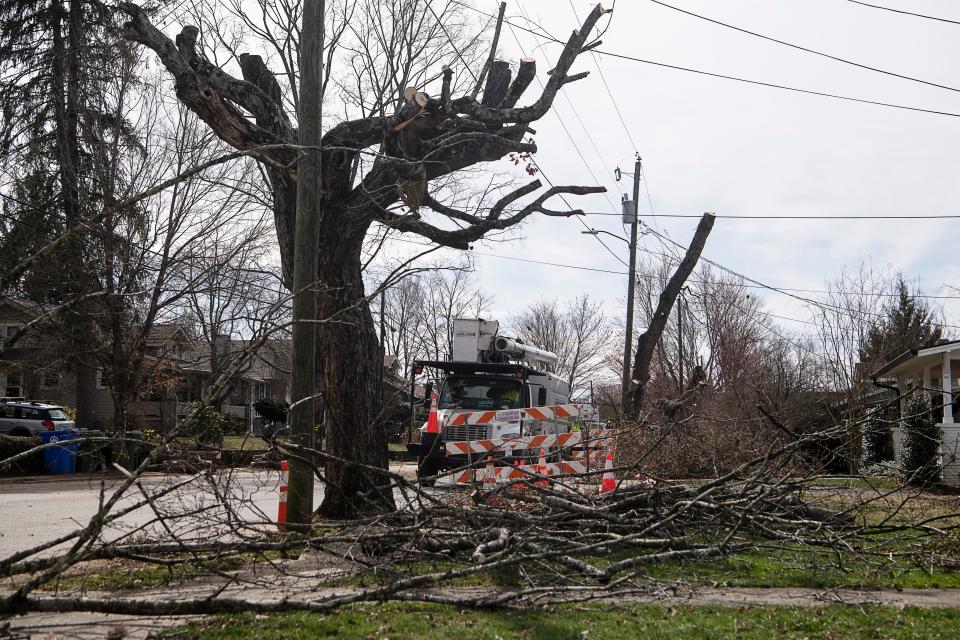Opinion: Whether from natural causes or development, loss of Asheville urban trees is sad
This year, March 17 is officially Arbor Day in North Carolina. While Arbor Day, first held in Nebraska in 1872, traditionally celebrates the planting of trees, this holiday should also be observed as a day of mourning for the thousands of trees we lose each year in Asheville and Buncombe County.
The death of a tree, whether from natural causes or from development pressures, is always sad. As the director of Asheville GreenWorks, I often receive phone calls from distraught community members who are frantically trying to save a tree that is being removed. Unfortunately, by the time I receive these calls, it’s usually too late to do anything to save the tree. Sometimes the tree is too sick from disease or pests. Other times, a homeowner has already made plans to remove a tree to put in a new driveway or an addition.
When I hear about trees being cut down, no matter the reason, it hurts my heart. Whether they are the stately maples on Vermont Avenue being removed to fix the sidewalks, the trees being cut to improve the municipal golf course, or the acres that are deforested to make way for new developments, I grieve. In my neighborhood, there is a beautiful, majestic 250-year-old white oak that has been designated by GreenWorks as a Treasured Tree. I can’t imagine it not being there.
More:Answer Woman: Branches leaning against powerlines? Who is responsible for tree trimming?
More:What's the latest at Asheville Municipal Golf Course? Tree removal, ongoing litigation

A 2019 study of changes in Asheville’s tree canopy over a 10-year period, from 2008 to 2018, showed a 6.4% decrease in average tree canopy cover across the city. Some neighborhoods saw a much higher percentage of their urban forest lost. West Asheville Estates experienced a staggering 33% decrease of its canopy cover during that period. In a single decade, Asheville lost 18,000 trees or about 890 acres of trees. Despite the best efforts of the Asheville Urban Forestry Commission and GreenWorks’ Tree Protection Task Force, we are still losing trees faster than we are replacing them. And, a newly planted tree has nowhere near the ecological benefits that a mature canopy tree provides.
The social, ecological, economic, psychological and health benefits that trees provide have been well-documented. We all know that trees take in carbon dioxide and breathe out oxygen, but did you know that trees actually lower crime rates, improve our mood and boost the economy? Trees are also our best defense against local impacts of climate change such as heat exposure and flooding.
Looking across the horizon to see green mountains surrounding Asheville, it’s easy to take trees for granted. However, if you walk around downtown on a summer day, you realize quickly that there are few trees in our urban center. City trees have to be of hardy stock. They are subjected to all sorts of hazards and harm ― people breaking off their branches, cars scraping their bark as they park, their planting pits being used as ashtrays and trash receptacles and harsh growing conditions.
More:Editor: Open call for women to share their voices, during Women's History Month and always
GreenWorks is partnering with the City of Asheville and Buncombe County to grow thousands of trees at our Native Tree Nurseries in East and West Asheville for planting in public spaces. It takes at least two years to grow our little trees to a size where they can be given away at our tree adoption events. It takes about five years for our trees destined for public spaces to grow to the necessary size. Much of this work is being done by our TreeKeeper volunteer workforce and others who volunteer their time and expertise at our nurseries.
To make sure the native trees that we’re growing have the best chance at survival, we offer workshops on how to plant and care for trees. To help protect trees on public property and those affected by commercial developments, GreenWorks has a seat on the city’s Urban Forestry Commission and coordinates a non-governmental volunteer Tree Protection Task Force. We also provide a mechanism for recognizing significant trees through our Treasured Trees program.
The future for trees, and consequently Asheville’s inhabitants, looks bright. GreenWorks just hired our first Community Forestry Coordinator to lead our community-based efforts to reforest Asheville and Buncombe County. And Asheville just hired its first Urban Forester, following a four-year effort by members of the Urban Forestry Commission, GreenWorks and countless passionate individuals.
Losing trees is inevitable. But, by protecting our large, mature trees and planting new trees in places where they’ll thrive, we can save our urban forest.
GreenWorks will be celebrating Arbor Day on April 29 at our Hardesty Lane Native Tree Nursery by planting 100 trees. For more information, visit ashevillegreenworks.org.
Dawn Chávez is the executive director of Asheville GreenWorks. She lives in West Asheville.
This article originally appeared on Asheville Citizen Times: Asheville urban forest is declining time to save mature trees

